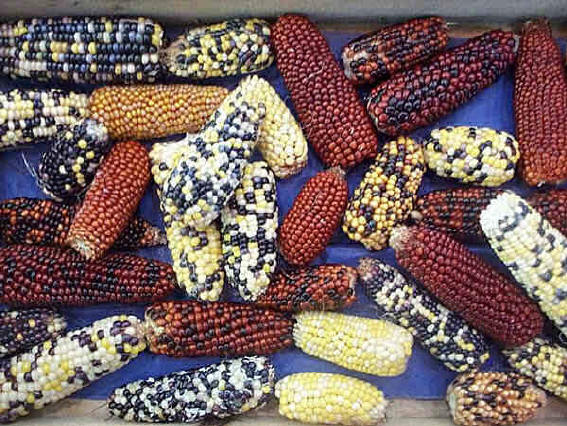Mary Staub
Adams County Master Gardener
Spring is just around the corner and it is time to think about spring planting. Are you a vegetable gardener, strictly floral, or a bit of both? Do
you like to experiment with out of the ordinary plants? One plant to consider is the ornamental corn plant. Its yield will provide you with lovely autumn decorations for your
home and provide the birds with food. Whatever the reason for planting this corn, the results will be much appreciated this coming autumn.

History of Corn
Corn was introduced as food to the early settlers by the Indians of both North and South America. Today ornamental corn is grown for its hard ears of
bright shades of orange, red, and golden yellow. You will find this corn in table and door displays. However, the corn plant offers an interesting display in the garden
during the growing season. And there are many new varieties to explore, too!
Corn is categorized into four groups based on the shape of the seed or kernel: field corn, popcorn, ornamental corn, and sweet corn. Ornamental corn
is a flint corn with very hard kernels that are difficult to grind.
Planting Ornamental Corn
My husband plants a summer vegetable garden each year. I remember once when he planted corn in rows. Recently I was reading a gardeners blog. I
learned from another gardener that they recommend planting the seeds about 8 - 9 inches apart and in a square formation, not in rows. By clustering the plants you increase
the chance of pollination. Also the stalks will survive a strong wind storm.
A well drained soil is essential to achieve high quality ears. Plow the seedbed several weeks before planting to allow the ground to settle and for
grass to decompose. Disk the soil three to four times before planting to prepare a good seedbed.
For best results, ornamental corn seed should be planted after the soil temperatures are between 56 degrees F. and 60 degrees F. For the corn to
mature in time for September harvest, planting should be between May 15 and May 25, or 80 days before harvest. Seed germination will be lowered under cold, wet soil
conditions.
Sow the seed 1 to 2 inches deep and 8 to 10 inches apart in the row for small eared cultivars, 10-12 inches apart for large eared cultivars. The rows
should be 30 to 42 inches apart depending on the equipment used to plant and cultivate. Again, small vegetable gardeners may want to try the square garden technique as
mentioned earlier in the article.
Soil pH is critical to a good harvest. A pH range between 5.5 and 6.8 is good. Add lime to soils to bring the pH to 6.5.
There are various types of ornamental corn cultivars: Broom Corn (red), Indian Art, Fiesta, and many more. An excellent resource is a web site from
the University of Kentucky, www.ca.uky.edu/agc/pubs/ho/ho81/ho81.htm. Here you will get information on planting and diseases common to ornamental corn.
Insect Control
Ornamental corn is not exempt from insect damage. Wireworms and cutworms can present a problem before the planting. Early weed control can help reduce
this problem.
After planting, insect damage is likely, too. Several problem insects can include rootworms, armyworms, corn earworm, cutworms, European corn borers,
and many more. Plant diseases can hurt the crop as well.
Harvesting
It is ready to harvest when the tassels turn color. Unlike the edible variety, the ears can stay on the stalks until you are ready to harvest them -
unless raccoons are smart enough to find it!
Pick the corn and pull back the corn husks to reveal the kernels. The corn needs to cure and should be hung from hangers in a barn or dark airy room
from rafters. As it cures the colors get darker and the husks dry out. The reason it's hung in the rafters is to keep the mice and raccoons away from it! Before using the
corn in your creative display, spray varnish the ears to preserve them.
Uses of ornamental corn
- Wall and door hangings can be made by tying three to five ears together with ribbon and bow.
- Ornamental corn wreaths can be made from smaller ears of corn. To build your wreath, wire the ears onto a circular wire (an old metal clothes
hanger works well and has a readymade hook for hanging.)
- Add to ornamental gourd arrangements.
- The individual kernels work well for jewelry and seed crafting. Use the good seed from a bad ear of corn. Let the ear dry and strip off the
kernels.
- A century old use is making dolls, flowers, wreaths, and paper from dried corn husks.
Explore the seed catalogs and search the Internet for new varieties of ornamental corn. Plant a few stalks to see what colors you will end up with.
Then enjoy the variety or colors you get and the compliments from neighbors and friends.
Read other articles on growing herbs or vegetables
Ornamental Corn Yields Fall Pleasure
Read other article by Mary Staub